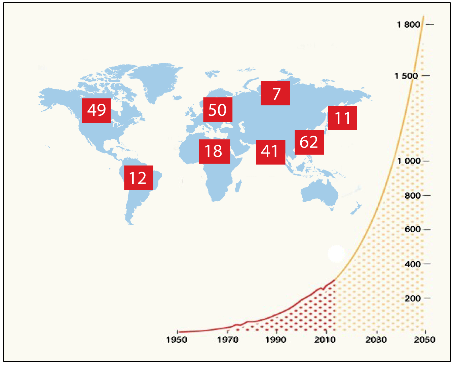3. BUSINESSES EFFORTS TO ENHANCE RECYCLING FROM CONSUMPTION
Resources are finite, but human ingenuity is not!
The role of business is crucial to the efficiency of waste management processes.
An analysis by the Federal Ministry for the Environment, Nature Conservation, Nuclear Safety and Consumer Protection (Germany) shows “The most common packaging materials are glass, paper, cardboard, plastic, tin, aluminium and wood” (https://www.bmuv.de/en/topics/water-resources-waste/circular-economy/types-of-waste-waste-flows/packaging-waste).
Paper and cardboard account for the largest share of packaging, with plastic and glass a close second. In figures, the graph looks like this:
In 2020, packaging waste generated is estimated at 177.2 kg per capita in the EU. This amount varies between 66.0 kg per capita in Croatia and 225.8 kg per capita in Germany. In 2020, paper and cardboard (41.2%), plastic (19.5%), glass (19.1%), wood (15.1%) and metal (5.0%) are the most common types of packaging waste in the EU. Other materials represent 0.1% of the total packaging waste generated in 2020.

Packaging waste generated by packing material, EU estimate, 2020 (%)
Source: Eurostat
The problem with packaging arises because of the transience of its use and its increasingly local use due to people’s desire to make their daily lives easier. Thus, reusable packaging is being replaced by disposable packaging. Thus, regardless of the type of packaged good, waste is generated from its packaging.
The Centre for Sustainable Circuits identifies the problem of plastic packaging in the following way: plastics are a product of human innovation as they are light, durable, resistant to decay, cheap and mouldable. This innovation comes at a price – Plastic packaging is extremely wasteful and impacts the Earth’s ecosystems on which we depend. Due to poor product design and lack of policy infrastructure, the majority of plastic waste is sent to landfills or dumped into the environment. 9.2 billion tonnes of plastic are produced, of which only 9% is recycled properly. (https://supplychain.edf.org/resources/sustainability-101-packaging-waste-the-problem/)

Global plastic production, million tones 2013
We should remember that plastic is not biodegradable; every piece of plastic ever produced is still on this planet. Companies continue to make heavy use of single-use plastics. The chart shows the projected fourfold increase in tonnage of plastic production by 2 050.
Packaging has several main functions – to protect items during delivery, for marketing and aesthetic purposes, and to contain information required by legislation. Thus, in addition to the packaging, the presence of a label is mandatory, which is another obstacle to the subsequent processing and recycling of packaging, as the material used is heterogeneous. Most packaging for consumer goods, such as food, beverages, cleaning products, shampoo, etc., is used only once before being discarded. Many people and companies simply throw away packaging without a second thought, especially if the packaging is not designed to be reused or recycled.
The main ways in which businesses can support recycling processes are – designing and manufacturing recyclable goods, establishing policies for using products made from or containing recycled materials.

 Español
Español Turkish
Turkish български
български Magyar
Magyar Polski
Polski Português
Português